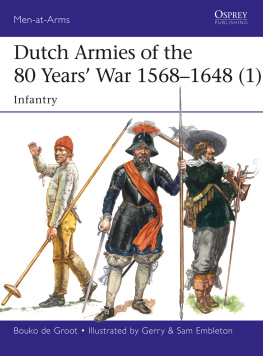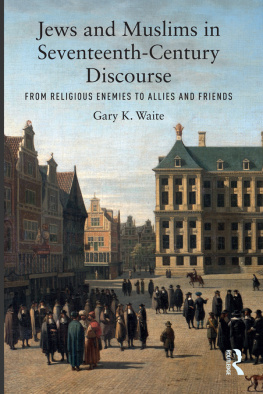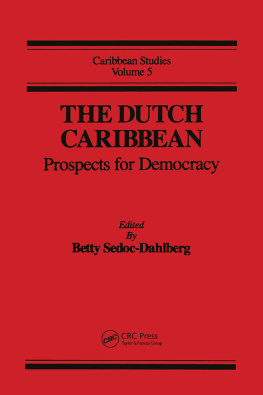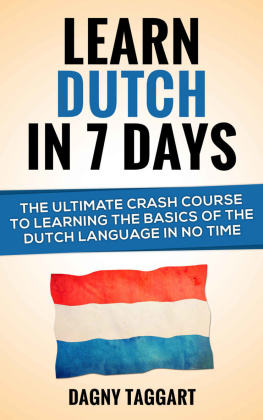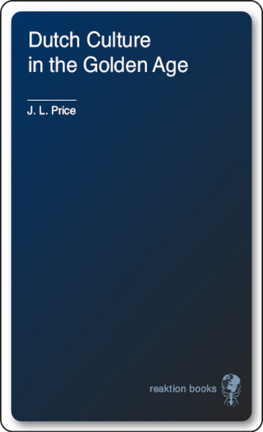CHRONOLOGY
The following gives a bare listing of the main events and the open-field battles of the 80 Years War, the latter numbered as on the accompanying map, with grid squares.
Soon after the start of the war it was realized that it could never be decided by pitched battles; economic control was more important, and that meant control over cities. The aim of most campaigns by both sides was thus to capture, besiege or relieve strategic cities and towns, rather than to meet and destroy enemy armies in the open field. This important positional warfare sieges, assaults, sallies and captures, decided by artillery, engineering and bloody trench warfare will be covered in the forthcoming second volume, along with the cavalry.
Only actual engagements are listed here; there were numerous episodes of manoeuvre and counter-manoeuvre that did not end in bloodshed, like the many face-offs during the Gulik Wars in Germany the War of the Jlich Sucession (160914), when the United Provinces and Spain supported different sides, but avoided combat due to the 12 Years Truce between them. (And in 1624 a 3,000-man Spanish raid from Ede to Arnhem is said to have turned back simply because one lone citizen was heard playing the Dutch national anthem on his trumpet.) During the overlapping 30 Years War phase (162148) Catholic armies repeatedly marched up and down the borders shadowed by Protestant forces, with neither initiating engagements. Note, too, that although they are not listed in the Chronology, throughout the war Dutch land campaigns were supported by naval actions attacks on Spanish ships, landings, relief convoys, raids on ports and Spanish communications, etc. which were increasingly successful and significant.
While the wars starting date is traditionally accepted as 23 May 1568, the day of the victory at Heiligerlee, 1566 had already seen the Petition of the Beggars, a tide of religious iconoclasm, William of Orange and other senior nobles meeting to discuss armed resistance, and clashes at Waterloo (now Wattrelos, 01 on map) and Lannoy (02, both in grid A1). In 1567 Alvas Bloody Council began its sessions, with 1,000 people executed and 11,000 banished. Many more Protestants fled, to become sea-beggars and forest-beggars, and there were encounters at Oosterweel (03, in B2) and Saint-Denis (04).
Civil War, 156887
1568 Whole population of the Netherlands declared heretic. First multi-pronged rebel invasion. In the north, actions at 05 Dalheim (D2), 06 Heiligerlee (E5), raid on Brussels, 07 Saint-Valery, 08 Jemmingen (E5), 09 Tongeren (D1), 10 Tienen (Tirlemont, C1), 11 Geldenaken (Jordoigne, C1). William and his brothers retreat into Germany; leading Catholic nobles Counts of Egmont and Horne executed in Brussels.
1569 12 Jarnac, 13 Moncontour (in aid of French Huguenots). Alva announces new taxes.
1570 Second rebel invasion falters before it really starts.
1571 Third invasion likewise aborted; Den Briel targeted.
1572 Fourth rebel invasion succeeds: 14 Den Briel (B3), 15 Saint-Ghisclain (B1), 16 Blokzijl (D4), 17 Goes (B2), 18 Overschie (B2), 19 Santpoort (C4), 20 Goes (B2), 21 Stavoren & 22 Koudum (C4), 23 Harmignies (B1), 24 Goes (B2). Spanish massacres in cities, e.g. Mechelen, Zutphen, Naarden.
157273 Alva slowly regains control in south and east, besieging Haarlem and cutting Holland in two: 25 Sparendam, 26 Heemstede/ Manpad, 27 Haarlem, 28 Diemerdijk, 29 Heemstede/ Manpad (all C4), 30 Maaslandsluis & 31 Poldervaart (B3). Alva replaced by Don Luis de Requescens.
1574 Leiden besieged; 32 Alphen aan de Rijn (C3), 33 Mookerheide (D3), 34 Maaslandsluis, 35 Vlaardingen, 36 Poldervaart (all B3). First Spanish Armada, against Holland, falters before it leaves port. Bloody Council stands down.
1575 First peace negotiations fail on religious grounds. Revolt spreads southwards again; more Spanish massacres.
1576 The Spanish fury: sack of Antwerp by unpaid Spanish soldiers kills c. 8,000 citizens. In response, Protestants and Catholics unite in the Pacification of Ghent, forming first national army with mutual religious toleration. 37 Vissenaken (C1).
1577 Complex three-cornered negotiations between States General, William and Spanish governor Don Juan of Austria fail. States General ask Philip IIs nephew Archduke Matthias of Austria to rule. 38 Luik/ Liege (D1), 39 Amsterdam (C4).
1578 Religious polarization destroys rebels unity; government moves from Brussels to Antwerp. 40 Gembloers/ Gembloux (C1), 41 Limburg (D1), 42 Rijmenam (C2). Spanish reconquer south; on Don Juans death Alexander Farnese (named Duke of Parma from 1586) is appointed governor, serving until 1592.
1579 Parma manipulates religious divisions; Netherlands divide between southern, mostly Catholic, royalist Union of Atrecht (Arras), and northern, mostly Protestant, rebellious Union of Utrecht. 43 Woensel (C2), 44 Borgerhout (B2), 45 s Hertogenbosch (C3), 46 Baasrode (B2).
1580 William of Orange outlawed; makes treaty with Duke of Anjou, brother of King of France. 47 Ingelmunster (A1), 48 Hardenberg (E4), 49 Steenwijk (D4)
1581 Matthias of Austria leaves. Northern provinces declare their independence. 50 Kollum (D5), 51 Goor (E3), 52 Noordhorn (D5).
1582 Duke of Anjou, offered throne with limited powers, arrives with small French army.
1583 The French fury; Anjous attempted coup in Antwerp fails, and he leaves Netherlands. Government moves to The Hague. 53 Antwerp, 54 Steenbergen, 55 Hulst (all B2).
1584 William of Orange assassinated. 56 Terborg (D3, part of Cologne War).
1585 England sends 6,000 men under Earl of Leicester in official support. Maurice becomes stead-holder. Siege of Antwerp 57 Kouwensteinsedijk & 58 Lillo (B2); 59 Amerongen & 60 Nijmegen (D3).
1586 States General grant Leicester wide powers, but his greed for more, his coup and his military failures destroy his credibility. 61 Boksum (D5), 62 Werl (part of Cologne War), 63 Grave & 64 Warnsveld (D3).
1587 Leicester leaves Netherlands. 65 Engelen (C3).
War for Independence, 15881620
1588 The Justification or Deduction is published (government should be exercised by the States General, not by an individual, i.e. the birth of the Republic). Anglo-Dutch defeat of Second Spanish Armada sent to transport Parmas army to England.
1589 Spanish defeat of English Armada to Corunna and Lisbon led by Sir Francis Drake. 66 Amersfoort (C3), 67 Rijnberk/ Rheinberg (D2). Spain distracted by French Wars of Religion; Parma leaves for France.
1590 Maurice begins counter-offensive, capturing Breda (C2).
1591 68 Knodsenburg (D3), 69 Lingen (E4).
1593 70 Tolbert D5), 71 Turnhout (C2), Luxembourg expedition.
1595 72 Lippe; first major army exercises; Metz expedition to aid French allies.
1596 Republic recognized by England and France in Triple Alliance. Anglo-Dutch raid on Cadiz.
1597 73 Turnhout (C2).
1598 Death of Philip II, succeeded by Philip III.
1599 74 Heerewaarden (C3).
1600 75 Leffinge (A2), 76 Nieuwpoort (A2) landmark Dutch victory.

